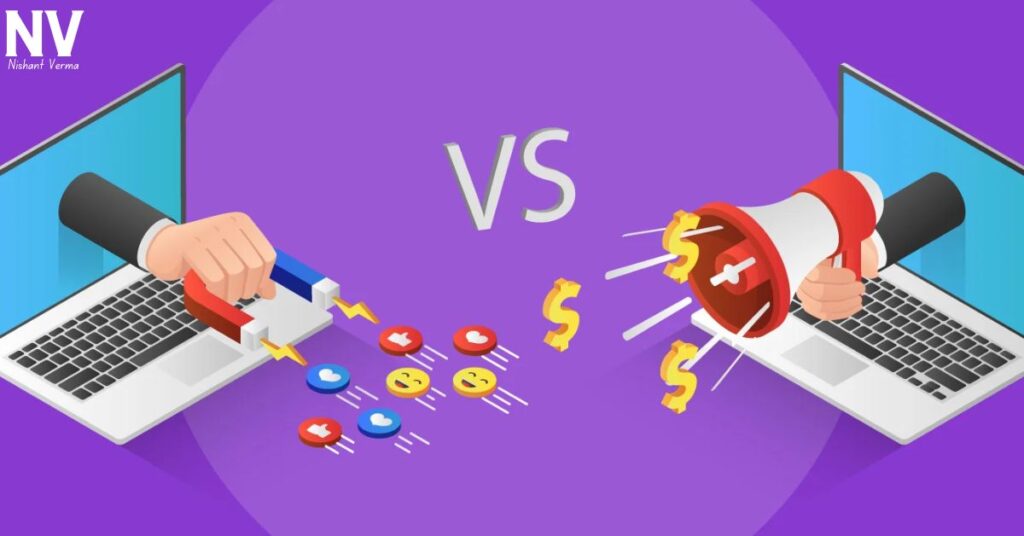In the ever-evolving realm of marketing, businesses are faced with the crucial decision of choosing between inbound and outbound marketing strategies. Both approaches have their merits, but finding the right mix is key to a successful marketing strategy. In this article, we’ll delve into the world of inbound and outbound marketing, exploring their differences, strengths, and how businesses can strike the perfect balance for optimal results.
Section 1: Understanding Inbound Marketing
1.1 Definition and Core Principles
- Define inbound marketing and its focus on attracting, engaging, and delighting customers.
- Highlight the core principles of inbound, including content creation, SEO, and social media.

1.2 Building Relationships through Content
- Explore how creating valuable and relevant content establishes trust with the audience.
- Discuss the importance of blog posts, ebooks, and other content in inbound strategies.
Section 2: The Power of Outbound Marketing
2.1 Definition and Traditional Tactics
- Define outbound marketing and its more traditional, interruption-based approach.
- Discuss traditional tactics of outbound like TV commercials, print ads, and cold calling
2.2 Instant Reach and Visibility
- Highlight the ability of outbound marketing to reach a large audience quickly.
- Discuss the role of outbound tactics in creating brand awareness.

Section 3: The Pros and Cons of Inbound Marketing
3.1 Pros
- Discuss the cost-effectiveness of inbound marketing.
- Explore the long-term benefits of building a loyal and engaged audience.
3.2 Cons
- Address the time it takes to see significant results from inbound efforts.
- Discuss the challenges of standing out in a crowded online space.
Section 4: The Pros and Cons of Outbound Marketing
4.1 Pros
- Highlight the immediate impact and reach of outbound campaigns.
- Discuss the ability to target specific demographics through outbound channels.
4.2 Cons
- Address the higher costs associated with many outbound strategies.
- Explore the potential for audience resistance to interruptive marketing.

Section 5: Finding the Right Mix: inbound and outbound marketing
5.1 The Integrated Marketing Approach
- Explore the concept of integrated marketing approach both inbound and outbound marketing strategies.
- Discuss how an integrated approach can capitalize on the strengths of both methods.
5.2 Analyzing Target Audience and Goals
- Emphasize the importance of understanding the target audience and goals and business goals.
- Guide tailoring the marketing mix to align with specific objectives.
Section 6: Case Studies
6.1 Successful Inbound and outbound Marketing Cases
- Showcase businesses that have excelled with inbound strategies.
- Highlight how content-driven approaches have led to organic growth.
6.2 Successful Outbound Marketing Cases
- Present examples of businesses that have achieved success through outbound channels.
- Discuss how targeted outbound campaigns have resulted in increased brand visibility.
Section 7: Navigating the Digital Landscape
7.1 The Role of Technology
- Discuss the impact and role of technology on both inbound and outbound marketing.
- Highlight tools and platforms that can enhance the effectiveness of each strategy.
7.2 Adapting to Changing Consumer Behavior
- Explore how consumer behavior influences the effectiveness of marketing strategies.
- Discuss the importance of staying agile and adapting strategies to evolving trends.
Conclusion:
In conclusion, the world of marketing isn’t about choosing between inbound or outbound marketing strategies like picking between apples and oranges. It’s more like making a fruit salad – combining the best of both worlds for a tasty result. We’ve explored the ins and outs of inbound marketing, where building relationships through valuable content takes centre stage. On the other side, outbound marketing shines with its ability to grab attention and create instant visibility quickly.
But here’s the secret sauce: businesses don’t have to choose one over the other. Instead, they should take a thoughtful approach, like a chef deciding the perfect mix of ingredients. The key is understanding your business like no one else does – knowing your audience, your goals, and what makes your brand unique.
If your goal is to form lasting connections with your audience, inbound and outbound marketing strategies are like planting seeds. It takes time, but the fruits of your labour (or should we say content?) are sweet and long-lasting. On the flip side, if you’re looking for a quick boost in visibility, outbound tactics are like turning on a spotlight. Your brand gets noticed instantly, like fireworks in the night sky.
The magic happens when businesses embrace both approaches, creating a marketing strategy that’s like a harmonious melody. Analyzing your unique circumstances is like tuning your guitar – finding that perfect balance that resonates with your audience.
Remember those successful businesses we talked about earlier? They didn’t stick to just one strategy. They adapted, evolved, and blended their approaches based on what worked best for them. It’s not about inbound OR outbound; it’s about the magic that happens when you integrate both. Your business is a unique recipe, and finding that perfect mix is the secret to a well-rounded and impactful marketing campaign.
In the end, success is like a symphony – the integration of the strengths of both inbound and outbound marketing. So, as you navigate the marketing landscape, don’t limit yourself to binaries. Embrace the power of a balanced approach, and you’ll find your business hitting all the right notes in the hearts and minds of your audience. It’s not just marketing; it’s the art of blending and creating a masterpiece that stands out in the crowded world of business.




